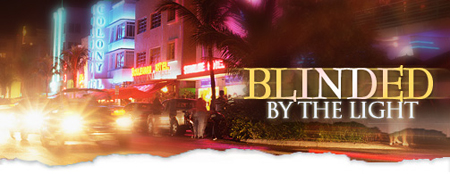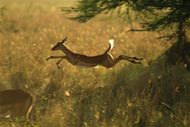|

Night
Driving - Vision in the Dark
by Jessica Howell
Daylight
Savings Time has come and gone, leaving
most daily commuters in the dark on long
drives home. While driving at night may
not seem like a significant issue for
experienced cruisers, it's a serious threat
for most people-many of whom experience
blurred distance vision and have difficulty
seeing signs, exits, and in some cases,
pedestrians.
 According
to the National Safety Council (NSC),
90 percent of a driver's reaction is dependent
on their vision. Additionally, the NSC
and the National
Highway Traffic Safety Administration
(NHTSA) reveal that fatality rates at
night are three times higher than those
during the day. According
to the National Safety Council (NSC),
90 percent of a driver's reaction is dependent
on their vision. Additionally, the NSC
and the National
Highway Traffic Safety Administration
(NHTSA) reveal that fatality rates at
night are three times higher than those
during the day.
To shed light on the issue, a recent survey
was conducted on behalf of ROAD &
TRAVEL Magazine and Acuvue Brand Contact
Lenses. The results were surprising, exposing
the fact that 53 percent of drivers admit
feeling uncomfortable during dark drives;
and nearly one in three drivers report
difficulty seeing all or most of the time
while driving at night.
"Driving in dark conditions is one
of the most hazardous situations faced
by a driver," says Courtney Caldwell,
editor-in-chief of ROAD & TRAVEL Magazine.
"Roads with low or no lighting, glare
from headlights and fluctuations in vision
are contributing factors to the disproportionately
high rate of car accidents and fatalities
that occur between dusk and dawn."
 Dr.
Elsie Brisco, a Los Angeles optometrist,
further explains. "Low light levels
cause the eye's pupil to dilate, which
can actually make existing focusing problems
even worse," says Dr. Brisco. For
drivers with the common vision condition
astigmatism, characterized by oval shaped
eye surfaces, blurred vision is even more
likely. Also likely, adds Dr. Brisco,
is the possibility of eyestrain or fatigue. Dr.
Elsie Brisco, a Los Angeles optometrist,
further explains. "Low light levels
cause the eye's pupil to dilate, which
can actually make existing focusing problems
even worse," says Dr. Brisco. For
drivers with the common vision condition
astigmatism, characterized by oval shaped
eye surfaces, blurred vision is even more
likely. Also likely, adds Dr. Brisco,
is the possibility of eyestrain or fatigue.
The survey, conducted by Kelton Research,
questioned a group of 515 vision-corrected
adults in order to find out, aside from
science, what's going on behind the wheel
when the sun goes down. As it turns out,
women are worrying more than their male
counterparts. Twenty-seven percent of
female survey-takers report feeling more
uncomfortable in the driver's seat due
to their vision problems, while 25 percent
of women feel both less safe and more
anxious when driving in the dark. Men
also admitted to similar feelings, but
in smaller numbers.
Also on the forefront of women's minds
is sensitivity to light on the road, in
the form of headlights from traffic, glare
and "halos" that appear around
lights at night.
 Says
Caldwell, "Women are especially concerned
with safety matters, both on the road
and off. Between driving to and from work,
carpooling, and running errands, we often
find ourselves driving at all times of
the day. Because of these various tasks
women spend more time on the road than
do men. For this reason, it's especially
important that women take the time to
educate themselves on the perils-and solutions-to
the dangers of night driving." Says
Caldwell, "Women are especially concerned
with safety matters, both on the road
and off. Between driving to and from work,
carpooling, and running errands, we often
find ourselves driving at all times of
the day. Because of these various tasks
women spend more time on the road than
do men. For this reason, it's especially
important that women take the time to
educate themselves on the perils-and solutions-to
the dangers of night driving."
To enlighten women and men on automotive
safety matters, ROAD & TRAVEL Magazine
offers several safety-related sections,
including Automotive Safety & Security,
Auto Oopsies, Vehicle Safety Ratings and
created specifically for women, What Women
Want. So, what should drivers do to prepare
themselves for night driving, especially
during the early eves of winter months?
Take the following steps to ensure
the safest drive possible:
-
Have
your eyes checked. Nearly half of Americans
report not having seen an eye care professional
for an exam in over a year; one quick
visit could diagnose any problems and
point you in a healthier direction.
-
Prep
your vehicle for night driving. Clean
headlights, taillights, signal lights
and windows (both inside and out) once
a week.
-
When in doubt, turn your headlights
on. Whether it's dusk or a dreary day,
lights help you to see better and make
you easier seen.
-
When
following another vehicle, keep your
headlights switched on low beam, so
you don't blind the driver in front
of you. In the instance that a fellow
driver doesn't offer the same courtesy,
and you're a victim of glare, keep your
eye on the right edge of the road and
use it as a steering guide.
-
Make
frequent stops for snacks and stretches.
Movement and light food will help ward
off tiredness.
-
Pay
careful attention to your driving even
as the sun goes down. Twilight is one
of the most difficult times to be on
the road since driver's eyes are constantly
changing to adapt to the growing darkness.
About
one third of survey respondents who said
they have been diagnosed or treated for
astigmatism said they are most distracted
by trouble seeing or visual discomfort,"
says Dr. Brisco. "Compared to the
overall vision-corrected population, people
with astigmatism were significantly more
likely to report being disturbed by glare
or light sensitivity.
The good news is that almost all levels
of astigmatism can be optically corrected
with glasses, certain types of contact
lenses, such as Acuvue Advance for Astigmatism,
or surgery."
Possibly the most shocking statistic of
the survey, however, reported that while
73 percent of people believe correcting
their vision could improve night time
driving, only 27 percent have ever consulted
an eye care professional about treatments
or products available. Dr. Brisco recommends
contacting your eye care professional
immediately if you are experiencing any
vision problems or visual discomfort.
Any
vision problem left uncorrected or under-corrected
can result in tragic consequences on the
road. A comprehensive eye exam will include
testing to diagnose potential problems
and determine the correct form of treatment,
such as a new pair of glasses or contact
lenses," she said.
Sources: ROAD
& TRAVEL Magazine, Acuvue,
National Safety Council, National
Highway Traffic Safety Administration
Read the complete survey results:
http://www.acuvue.com/press.htm
|